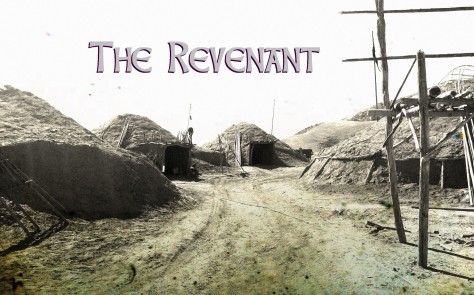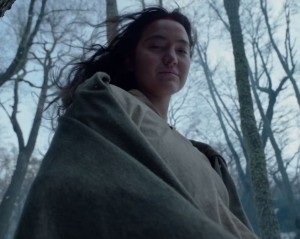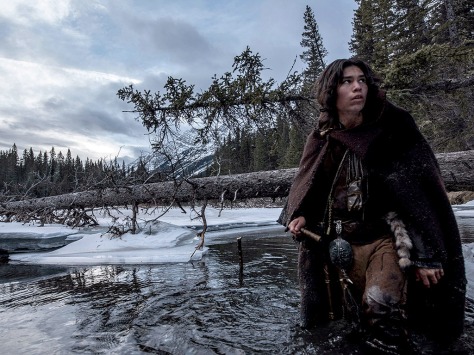
I saw The Revenant yesterday. My overall impression… I guess it was as if I had visited the ancestral world that would eventually give rise to the world of Mad Max. Fur-clad protagonists who wallow in the churning machinery of savagery will surely give birth to futuristic protagonists wallowing in the slow-motion disintegrating machinery of slaughter. The Revenant and Mad Max imagine very similar worlds. A brute grotesque vision of humankind. Dark dystopian fantasies. Parched outbacks and snowbound mountains provide the mythic vistas that generate one epic downfall after another. The savage people. The savage animals. The savage guns and gears. We find ourselves cast into sand storms, furiously gritty, and into rivers, furiously frigid. But we who enter such realms… we must endure scene after scene until the end comes for us all at last. When you leave this kind of theater, don’t bother looking back to ponder the bloody footprints at your heels.
But The Revenant was nice, in a way. It was wonderful to see cinematic Pawnees who were not murderous, who were not bent on terrorizing the innocent. Hugh Glass is given a sweet Pawnee wife – an anonymous dreamlike Mrs. Glass who floats in & out of the movie. Hugh misses her. It is terribly sad, the way she was murdered by unhistorical soldiers who senselessly savage a Pawnee city in an unhistorical massacre – it never happened in actual history, but it is a moment that fits seamlessly into our preferred pro-race mythmaking. And they have a son. “Hawk” is quite a well-chosen name – very common for Pawnee boys of that time. Hawk loves his father. He is loyal and caring and a little sad. He is so easily murdered in this dark fairytale.

Grace Dove as Mrs. Glass
Such humanized Pawnees are strangely absent from cinema. Not long ago I noticed a few Pawnees in The Homesman, a 2014 film by Tommy Lee Jones. When those Pawnees ride into the movie, the homesman grabs all his weaponry. He wisely hands a gun to the woman he’s traveling with, and he counsels her to blow her own brains out if he doesn’t survive the coming desperate negotiations. To fall into Pawnee hands… too horrible! And I haven’t even mentioned the nightmarish Pawnees of Dances with Wolves.
I long ago read a book by John Myers Myers about Hugh Glass and I always felt suspicious of his colorful tale – the part about Hugh Glass living among the Skidi Pawnees. That particular twist was based on notes made from interviews with a fur trade employee named George Yount. Seventy-some years later those interview notes were gathered, edited, and published, and I have no idea how those filters affected the story told by Yount. But the way the account framed Pawneeland has always felt to me like artifice warped for dramatic effect, not like history.
Perhaps Glass knew the Pawnees. The fur trade was very active in Pawneeland for decades before 1825. American fur trade corporations centered in St. Louis typically sent expeditions to Pawneeland to set up shop in the different cities. The association of Glass with the Skidi Pawnees was just a speculative interpretation of the Yount tale – a hyperventilated twist introduced by Myers. I don’t see how it is trustworthy in any way. The Yount / Myers tale has Glass as a prisoner who wins his way into the hearts of the Pawnees. But by the time Glass happened onto the scene, it wasn’t like he could have been held in a secret Pawnee prison for months or years. Pawneeland wasn’t really a realm that teetered at the mysterious edge of everything else. It was instead a close-knit alliance of four Pawnee sovereignties that had long before become interlocked in the global patterns of commerce and politics and intermarriage.
It is a shame that The Revenant makes us believe in its exquisitely detailed version of the past, its compelling Mad Maximum narrative truths, the frenzied whiplash thrills of maybe having to chop off a few fingers for good wholesome reasons, the next vastly defining moment of blood lost forever in endless snow. Despite all this gruesome drama, we are somehow wafted into a haunting world. And this is the first movie that has ever happened in my lifetime that shows Pawnees as people… And yet, well, it seems a shame. I find myself wondering… will I ever want to visit that version of the world again?

Forrest Goodluck as Hawk

I thought the Pawnees came off much better than the white men in this film. Yes, they were “savages”, but the white men were much more savage and inhuman. Strangely, of all the “peoples” in the film, the French come off the absolute worst. I actually appreciated the depiction of the Pawnees here. They were real. They weren’t simply savages, nor were they idealized “Noble Savages”. Race questions aside, I thought the movie was truly terrifying in many scenes. I was relieved when it was over. But the feeling has been growing in me ever since that I want to see it again. It’s a spectacularly beautiful film.
I’ve been researching Pawnee history since the late 1980’s and have a very different view of the stories told in Hollywood movies. The Pawnee were traders with the French and sometimes Spanish, stood their ground with their business dealings with outsiders. A proud and honest people. A long existence on the high plains…..
What about that poor jolly Pawnee in “Little Big Man”?
I would like to see a movie based on the Villasur fight